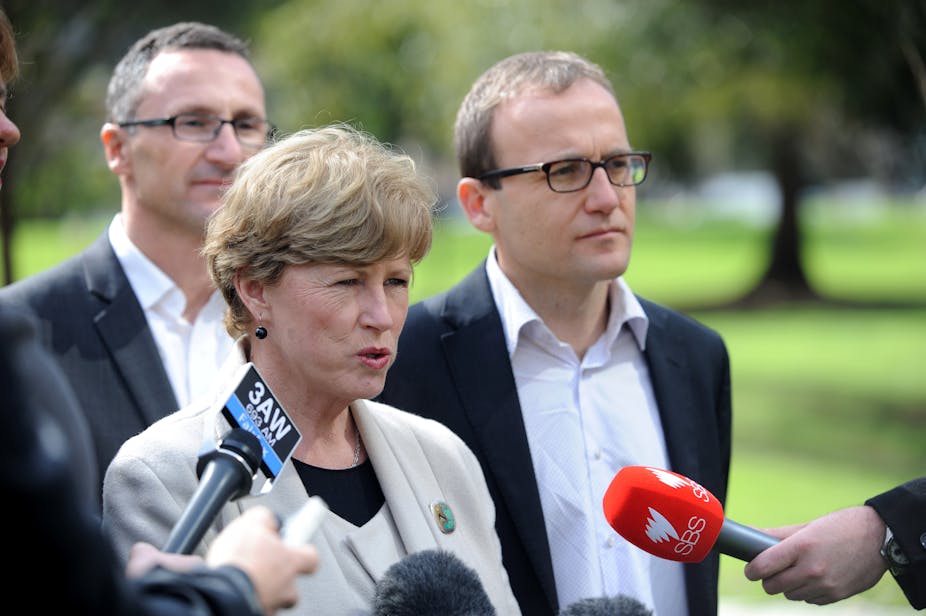In the final days of the election campaign, Greens leader Christine Milne implored voters to “Abbott-proof” the Senate by voting Green on election day.
Milne’s exhortation was, in many respects, an open admission that the Greens held out little hope of making any further electoral gains in the lower house, and that it was even facing a battle to retain seats in the Senate.
This was the first election that the Greens had much more to lose from the outcome than they stood to gain. The Greens were defending three Senate positions (Scott Ludlam, Peter Whish-Wilson and Sarah Hanson-Young), as well as Adam Bandt’s lower house seat of Melbourne. It had also set itself the ambitious target of securing an additional senator in Victoria (Janet Rice) and the ACT (Simon Sheikh).
But throughout much of 2013, the polling suggested that the Greens would not perform as strongly as they had in 2010. All signs indicated that it would be the profusion of right-of-centre minor parties that would cannibalise Labor’s collapsing primary vote, not the Greens. Newspoll put the Greens’ share of the national vote at anywhere between 9% and 10%.
The electoral hopes of at least three Greens incumbents also appeared to be in doubt because of a number of unfavourable preference decisions by competitor parties. The Liberals had come good on its threat to preference against the Greens, which represented a blow to Bandt’s prospects for re-election.
In Western Australia (and in New South Wales), renegade WikiLeaks Party state organisations defied the express instructions of the party’s National Council and preferenced right-wing parties ahead of the Greens. This decision had the potential to scupper Ludlam’s re-election chances in WA.
In South Australia, independent senator Nick Xenophon’s decision to direct his preferences to the major parties over Hanson-Young didn’t bode well for her prospects.
The results
In the immediate aftermath of the result, Milne stood before the party faithful and expressed disappointment at the outcome. There can be little doubt that the election result was something of a mixed bag for the Greens.
If the criterion for assessing a party’s success is based on it being able to either increase or consolidate its primary vote, then the result for the Greens is poor indeed. This was the first time since 1998 that the Greens share of the nationwide primary vote not only failed to grow, but that it declined.
There was a nationwide swing of 3.34% against the Greens in the House of Representatives, with their primary vote falling to 8.42%. A little over half a million voters who had supported the Greens at the previous election deserted them.
Swings were registered against the Greens in every state and territory. Some of the severest were recorded in Green strongholds, such as Tasmania (8.73%) and the ACT (5.95%).
There was also little joy to be found in the Greens’ Senate vote. Across every state and territory, the Greens’ primary vote took a battering (-4.39%). In Tasmania, the Greens recorded an 8.64% swing against them, while in South Australia its primary vote was almost halved (7.07% in 2013 compared to 13.30% in 2010).
But while the Greens’ primary vote floundered, there were some spectacular successes for the party. Bandt accomplished the herculean task of retaining the seat of Melbourne. Bandt recorded a 7.82% swing towards him in his primary vote, winning 43.41% of first preferences and 55.05% on a two-party preferred basis.
Similarly, at the time of writing, it appears that Whish-Wilson in Tasmania and Ludlam in WA will be re-elected without too much fuss, while Hanson-Young will likely be returned to the Senate. The Greens are poised to claim an additional Senate spot in Victoria, with the lead Senate candidate Janet Rice coming in just short of a full quota (0.7791) on primary votes.
It would seem that in spite of the collapse in Greens’ support in the Senate, the primary vote is sufficiently robust for the party to maintain a significant parliamentary presence.
The challenges ahead
Although the Greens are tipped to grow their parliamentary representation in the Senate, this is unlikely to translate into increased influence for the party in the upper house.
The most reliable estimates for the new Senate is that the balance of power will shift to various right-of-centre minor parties and independents. It has been reported that some of their numbers, led by Xenophon, have commenced preliminary discussions to combine in the Senate in order to make more effective use of their balance of power status. There will be few if any opportunities for the Greens to exert influence over the government’s proposed legislation.
It isn’t simply that the Greens are at risk of being sidelined in the Senate, but that the Coalition government may move against those that oppose them. An Abbott Coalition, impatient for the 30 June 2014 Senate changeover, might pursue the option of a double dissolution election if the Greens (or Labor) block the Coalition’s plans to repeal the mining and carbon taxes.
If Milne is correct and the electorate has taken a conservative turn, then it might be a disaster for the Greens to face the polls in the wake of an insurgent Liberal Party.
The other major challenge for the Greens will be to return its primary vote to double digits. This will be no easy feat for the party. In part, this is because most Australian voters have established partisan allegiances. Without a major realignment of the party system, it will be difficult for the Greens to diversify their base of support beyond their natural “post-materialist” constituency (estimated by some scholars to be around 10% of the electorate).
The Greens vote, it seems, may have reached its natural plateau. While this should not be interpreted as a sign that the Greens will go the way of the Democrats, it is a reminder of the fragile existence of minor parties in the Australian party system.

